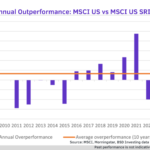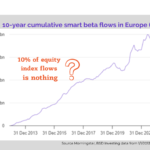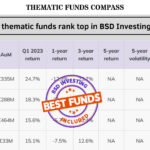Widely studied for several decades, with the famous study by Fama and French (1988, 2002), factor investing has continued to play an increasingly important role in academic research. Financial innovation has also seized this opportunity to offer various investment strategies and products such as ETFs, Smart Beta using new factors and increasingly complex quantitative methods.
Marlene Hassine Konqui, member of the ETF Committee of the SFAF, and Ahmed Khelifa, Chairman of the ETF Committee, take a look at investors’ interest in this type of strategy in the chaotic context of 2022, as examinate the role of Smart Beta in portfolio construction and factor performances since the beginning of the year1.
Flows towards Smart beta strategies in strong growth
In Europe, while Smart Beta strategies represent only 5% of index management assets, they account for 12% of inflows (according to the Morningstar classification), or €9bn since the beginning of the year. These strategies collect 17% of equity index flows, of which 70% to dividend strategies and the rest to value and risk-oriented strategies. For comparison, Smart Beta strategies accounted for 7% of flows in 2021.
In the United States, Smart Beta strategies represent 15% of index management assets and 28% of inflows in 2022, almost twice as much as in 2021 when Smart Beta accounted for 15% of flows. This is a record over the last 5 years. Note that 46% of flows to US equities in 2022 are flows to Smart Beta index funds, compared to 31% in 2021. In 2022, 50% of US Smart Beta flows went to dividend strategies, 16% to Value and 15% to the Growth factor.
Recent academic studies confirm the value of Smart Beta strategies to generate performance in portfolios over the long term.
The latest studies, such as that of Tessaromatis and Sakkas (Forecasting the Long-Term Equity Premium for Asset Allocation, Financial Analysts Journal, 2022) conducted in the U.S. equity market and those of 11 other developed countries, continue to support the idea that predictive models based on a factor approach provide statistically significant outperformance over the long term, compared to portfolio models built on the basis of the best known, which use the historical returns of the portfolios.
While factor strategies (including Smart Beta) are often used as complementary bricks in portfolio construction, some studies, such as those by Stefano Cavaglia, John Hua Fan and Zhenping Wang (Portable Beta and Total Portfolio Management, Financial Analysts Journal, 2022), tend to show that the integration of ARP (Alternative Risk Primera) strategies, in the construction of the core portfolio based on an approach aimed at diversifying factor exposures significantly improves the Sharpe ratio and, therefore, the risk-return ratio of a portfolio.
There seems to be a growing consensus on the value of capturing premiums for certain factors over the long term. But what about their relative short-term performance compared to a benchmark?
Which factor strategies held up best in H1 2022 this year and why?
Analysis of the relative performance of factors relative to benchmarks shows different results in H1 of this year, depending on the geographical area selected. This difference in results is mainly due to the divergence of monetary policies of different central banks and, in particular, between those of developed countries, which have experienced a rise in rates, and China, which has had a more accommodative policy. It also shows a significant underperformance of the quality factor and a significant outperformance of the “value” and “minimum volatility” strategies.
It’s all about underlying: Sector is King

Value’s low exposure to tech and its overexposure to energy and utilities were the main drivers of performance in H1. Conversely, the overexposure of Quality and Growth factors to tech and their underexposure to the energy sector weighed on their relative performance, making them the most negative contributors to the MSCI World Index. The Quality factor, which is supposed to protect portfolios through, among other things, the balance sheet strength of the companies it includes, has not played its expected role. It is thus clear, in a rather clear way, that, in the short term and in periods of market downturn, a sector approach is more relevant or, at least, it remains the one that takes precedence over the performance of markets and factors.
Marlene Hassine Konqui













Leave a Reply
You must be logged in to post a comment.